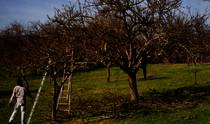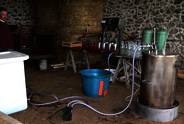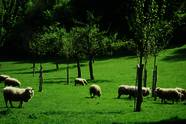
Past and present of traditional orchards in France: Between family production and organized PDO
At the peak of traditional orchard farming, in the early 1960s, France had the most extensive fruit orchard meadows in Europe, with one million ha and almost 146.000 today. The 1929 agricultural census gives an idea of the area formely covered by traditional orchards: 100 million of apple and pear trees (see table 1).
Data from the Farm Structure Survey concerning traditional fruit trees 1929
| Species | Number of trees in million | Production |
| Apple tree et pear tree for cider | 59 (whom 6% de pear trees) | 4 millions of tons whom 54% are self consumed, 23 millions of hl of cider. 358.000 cider press |
| Other traditional fruit trees | 51 (whom 42% of apple and pear trees) | 950,000 tons whom 49% are self consumed |
The 1929 agricultural census gives an idea of the area formely covered by traditional orchards: 100 million of apple and pear trees (see table).
Despite a rapid decrease during the period of agricultural intensification (1960-1990), traditional apple orchards still play a central role in specific livestock breeding areas, e.g. Low Normandy.
Home consumption, which in 1929 concerned almost half the production for cider apple and pear trees, remains high, especially for cider (51% in 2008). Even if the economical value of these productions has widely decreased, the production of cider and calvados still represents 260 million €, largely thanks to existing "Protected Designations of Origin" (Ciders, Perry, Calvados, Pommeau, Kirsch).
2002: 146,000 ha with 5 millions trees
From 1960-2000, traditional orchards have largely declined and about 85% of their surface has been lost. In 2002, French traditional orchards covered about 146,000 ha with 5 millions trees equalling 0.5% of the UAA. In Normandy, 11,000 farms are still producing apples for cider production.
Only 340,000 t of apple are harvested for a production of 1,260,000 hl of cider (2 litres/year/inhabitant, 1 l is self consumed) and 18,500 hl of calvados (14 litres of cider for 1 litre of 70% alcohol). The production of cider under PDO represents 110,000 hl, 17% of the commercialised cider. The production of apple juice is very low.
Direct marketing are of economical interest
Today, traditional orchards, 70% located in Normandy, are mainly composed of cider varieties (90% apple - linked to 10% pear); but it is still possible to find some traditional orchards of plum in Alsace and Lorraine, and a cheery orchard in Fougerolles for the "Kirsch" production. Also some orchards remain in mountainous regions. PDO products are mainly developed in Normandy, Brittany, Sarthe and Mayenne and traditional orchards are now better integrated in the PDO rules (1 ha minimum and at least 50% of intensive orchards). On-farm-processing and direct marketing are of economical interest. Organic products, such as apple juice yet have to be developed.
Traditional orchards are especially valued for their environmental and landscaping role and are havens for endangered species. In Alsace, 35 species of breeding birds have been counted, 10 of which are only found in these orchards. Half of these birds are cavernicolous, such as wrynecks, hoopoes, green woodpeckers, tree sparrows, starlings and tits. Plum orchards of Franche-Comté are home to a high density of wrynecks and redstarts – 41 species have been observed. A total of 75 species of birds have been observed in traditional orchards in France. A comparison between traditional and intensive orchards in Normandy shows that 58 species are observed in traditional orchards compared to 25 in intensive orchards.
Sustainable agriculture
French agriculture benefits from traditional orchards, as they contribute to the diversity of landscapes and to the identification of specific areas.
Traditional orchards are the archetype of sustainable agriculture: low input and low pressure on the environment while at the same time yielding products of high quality. The amenity of this system is now recognised in France under cross-compliance regulations of the European Union and in agro-environmental measures, with associated payments. Traditional orchards are identified as an ecological infrastructure (cross compliance, high environmental value certification, Green and Blue Network) and contribute to high nature value farmland. Thanks to the landscape value they are used to “sell” dairy products and the Normandy itself.
The future of traditional orchards mainly depends on the consumption level of their products. So it is a priority to develop the consumption of apple juice and cider and to promote these beverages to the young generation.










